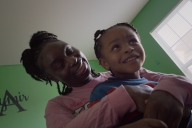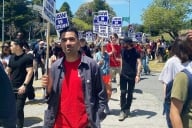You have /5 articles left.
Sign up for a free account or log in.
Gallaudet University announced Tuesday that it will try to make amends with its chief diversity officer, Angela McCaskill, who was placed on leave last week because she had signed a petition circulated by those campaigning against gay marriage rights in Maryland.
Last week, Gallaudet President T. Alan Hurwitz issued a statement that McCaskill had been placed on paid administrative leave so the university could take time to decide what to do. McCaskill, the statement said, had “participated in a legislative initiative that some feel is inappropriate for an individual serving as chief diversity officer." Since then, the university has faced a torrent of criticism from those who say that it should not have taken any action against McCaskill, while others have said that a chief diversity officer should not take a stance that would hurt gay people or any other group.
Tuesday, Hurwitz issued another statement saying McCaskill had simply “exercised her right to sign a petition” and that the university wants to work to bring her back. Hurwitz acknowledged that members of the university were “concerned and confused” by McCaskill’s decision to sign the petition, but said after considering the issue, he hopes McCaskill will return. McCaskill has been at Gallaudet for 23 years, and became the university’s first chief diversity officer in January 2011.
It’s unlikely, however, that Hurwitz’s latest statement will wrap up the conversation. In the time between the two announcements, critics have come out on both sides. Some, including a pro-gay marriage group, criticized the university for reacting to the private opinions of its employees; others others questioned how an administrator in charge of creating a safe environment for diverse populations could oppose gay marriage.
McCaskill herself has spoken out, too. She told WJLA after Tuesday's announcement that she could return that she feels bullied and is considering legal action; during a press conference, she said she feels intimidated by the university and will seek compensation for the mental and emotional distress it has caused her.
At many colleges and universities, students and faculty members have a range of views on gay rights and gay marriage, and express them throughout the political process. But the issue is more complicated for administrators who have responsibility for promoting equal opportunity on campuses. In 2008, a human resources administrator at the University of Toledo was fired after she published a newspaper column arguing that gay people don’t need civil rights protection. The administrator, Crystal Dixon, sued the university, but a judge ruled that Toledo was within its rights in firing Dixon because of the nature of her position; her comments, the judge ruled, would impact her ability to do her job.
That is the same argument McCaskill’s critics make, saying that because her job is to create a safe, inclusive environment for students of all races, ethnicities, genders, and sexual orientations, her signature on the petition interferes with that goal. McCaskill, however, emphasized that she merely exercised her right to sign a petition and did not actively espouse a particular opinion.
“Anyone who works at a university has the right to espouse any viewpoint, assuming that’s done in a respectful way,” said Benjamin Reese, president of the National Association of Diversity Officers in Higher Education and the vice president for institutional equity at Duke University. “But I think all of us in senior roles at colleges and universities recognize that there is not a clear demarcation between our college and university service and our private life.”
For diversity officers, Reese said, the line can be even fuzzier. Though he did not want to comment on McCaskill’s case without knowing the details, Reese did say that university administrators should recognize that often it is impossible to ever completely dissociate from their university role.
The line between a private action and a public action can be hard to pin down, too. Shane Windmeyer, the executive director of Campus Pride, pointed out that signing a petition is different from going into a voting booth. But signing a petition, he added, is also very different from standing outside with a picket sign.
“At the end of the day, it begs the question of what was she thinking,” Windmeyer said. “It’s also important to recognize that she has done many things in her job that were LGBT-supportive. I think we need to look at this situation from the lens of a student – the student should be able to sit down with the chief diversity officer and say, ‘What were you thinking?’ and then they should be able to share what they felt.”
Somewhat ironically, Windmeyer gave a speech at the Gallaudet campus on Oct. 11, one day after McCaskill was placed on leave. Windmeyer was the keynote speaker for National Coming Out Day, and his visit was funded by the chief diversity officer’s budget.
Students did ask Windmeyer for his opinion on McCaskill’s situation, and he says he told them that it was a good opportunity for discussion and for learning.
“The campus community needs to deal with this issue as a campus community,” he said, repeating the point he had made to Gallaudet students.
If McCaskill comes back, Windmeyer said, it would be wise for the university to look at her contract. He acknowledged that she is the first chief diversity officer Gallaudet has had, so this is new territory, and that for many universities, the term “diversity” does not automatically include gender or sexual orientation.
“On some campuses when we talk about diversity we’re still talking about ethnicity and race,” Windmeyer said. “Contracts need to look at the definition of what diversity means and what it includes.”
Reese agreed it is important for universities to viewing including the LGBT community as a critical component of creating a safe environment for diverse students. He said there may be some institutions that have not yet broadened their definition of diversity, but that most chief diversity officers view including LGBT students as part of their responsibility.
Windmeyer noted, however, that only about 13 percent of colleges include sexual orientation as part of their nondiscrimination statement, and said that until universities track retention and graduation rates for students of different sexual orientations the way they do for students of different races, they are not truly serving all groups at the same level.
“Right now, a chief diversity officer can look at campus safety for LGBT students and be accountable, but at the end of the day it’s about retention and graduation rates, and right now we don’t do anything about retention or graduation rates for our LGBT students,” Windmeyer said.
Reese believes most chief diversity officers are working to build a safe environment for all students, but adds, “It’s critical that chief diversity officers behave in a way that contributes to an inclusive environment, including the LGBT community.”








